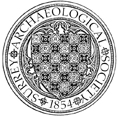The Old Vicarage, 183 Westhall Road, Warlingham
Appraisal by M Higgins of SCC of a T-shaped brick-built vicarage of two storeys and attics with five window bays to the front elevation. A special feature of the building is the pilasters applied to the front elevation and its left-hand flank. It has unusually long first-floor sash windows. Internally there is a very good collection of shutters to the windows and the original plan layout remains substantially unaltered. Manning and Bray (2, 340) thought it was built as a parsonage house by Harman Attwood who died in 1676.


